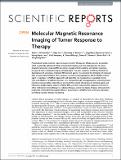| dc.contributor.author | Shuhendler, Adam J. | |
| dc.contributor.author | Ye, Deju | |
| dc.contributor.author | Brewer, Kimberly D. | |
| dc.contributor.author | Bazalova-Carter, Magdalena | |
| dc.contributor.author | Lee, Kyung-Hyun | |
| dc.contributor.author | Kempen, Paul | |
| dc.contributor.author | Graves, Edward E. | |
| dc.contributor.author | Rutt, Brian | |
| dc.contributor.author | Rao, Jianghong | |
| dc.contributor.author | Wittrup, Karl Dane | |
| dc.date.accessioned | 2015-12-29T00:10:35Z | |
| dc.date.available | 2015-12-29T00:10:35Z | |
| dc.date.issued | 2015-10 | |
| dc.date.submitted | 2015-04 | |
| dc.identifier.issn | 2045-2322 | |
| dc.identifier.uri | http://hdl.handle.net/1721.1/100549 | |
| dc.description.abstract | Personalized cancer medicine requires measurement of therapeutic efficacy as early as possible, which is optimally achieved by three-dimensional imaging given the heterogeneity of cancer. Magnetic resonance imaging (MRI) can obtain images of both anatomy and cellular responses, if acquired with a molecular imaging contrast agent. The poor sensitivity of MRI has limited the development of activatable molecular MR contrast agents. To overcome this limitation of molecular MRI, a novel implementation of our caspase-3-sensitive nanoaggregation MRI (C-SNAM) contrast agent is reported. C-SNAM is triggered to self-assemble into nanoparticles in apoptotic tumor cells, and effectively amplifies molecular level changes through nanoaggregation, enhancing tissue retention and spin-lattice relaxivity. At one-tenth the current clinical dose of contrast agent, and following a single imaging session, C-SNAM MRI accurately measured the response of tumors to either metronomic chemotherapy or radiation therapy, where the degree of signal enhancement is prognostic of long-term therapeutic efficacy. Importantly, C-SNAM is inert to immune activation, permitting radiation therapy monitoring. | en_US |
| dc.description.sponsorship | National Cancer Institute (U.S.) (Stanford University Center of Cancer Nanotechnology Excellence (1U54CA151459-01)) | en_US |
| dc.description.sponsorship | National Cancer Institute (U.S.) (ICMIC@Stanford (1P50CA114747-06)) | en_US |
| dc.language.iso | en_US | |
| dc.publisher | Nature Publishing Group | en_US |
| dc.relation.isversionof | http://dx.doi.org/10.1038/srep14759 | en_US |
| dc.rights | Creative Commons Attribution | en_US |
| dc.rights.uri | http://creativecommons.org/licenses/by/4.0/ | en_US |
| dc.source | Nature Publishing Group | en_US |
| dc.title | Molecular Magnetic Resonance Imaging of Tumor Response to Therapy | en_US |
| dc.type | Article | en_US |
| dc.identifier.citation | Shuhendler, Adam J., Deju Ye, Kimberly D. Brewer, Magdalena Bazalova-Carter, Kyung-Hyun Lee, Paul Kempen, K. Dane Wittrup, Edward E. Graves, Brian Rutt, and Jianghong Rao. “Molecular Magnetic Resonance Imaging of Tumor Response to Therapy.” Scientific Reports 5 (October 6, 2015): 14759. | en_US |
| dc.contributor.department | Massachusetts Institute of Technology. Department of Chemical Engineering | en_US |
| dc.contributor.department | Koch Institute for Integrative Cancer Research at MIT | en_US |
| dc.contributor.mitauthor | Wittrup, Karl Dane | en_US |
| dc.relation.journal | Scientific Reports | en_US |
| dc.eprint.version | Final published version | en_US |
| dc.type.uri | http://purl.org/eprint/type/JournalArticle | en_US |
| eprint.status | http://purl.org/eprint/status/PeerReviewed | en_US |
| dspace.orderedauthors | Shuhendler, Adam J.; Ye, Deju; Brewer, Kimberly D.; Bazalova-Carter, Magdalena; Lee, Kyung-Hyun; Kempen, Paul; Dane Wittrup, K.; Graves, Edward E.; Rutt, Brian; Rao, Jianghong | en_US |
| dc.identifier.orcid | https://orcid.org/0000-0003-2398-5896 | |
| mit.license | PUBLISHER_CC | en_US |
| mit.metadata.status | Complete | |
